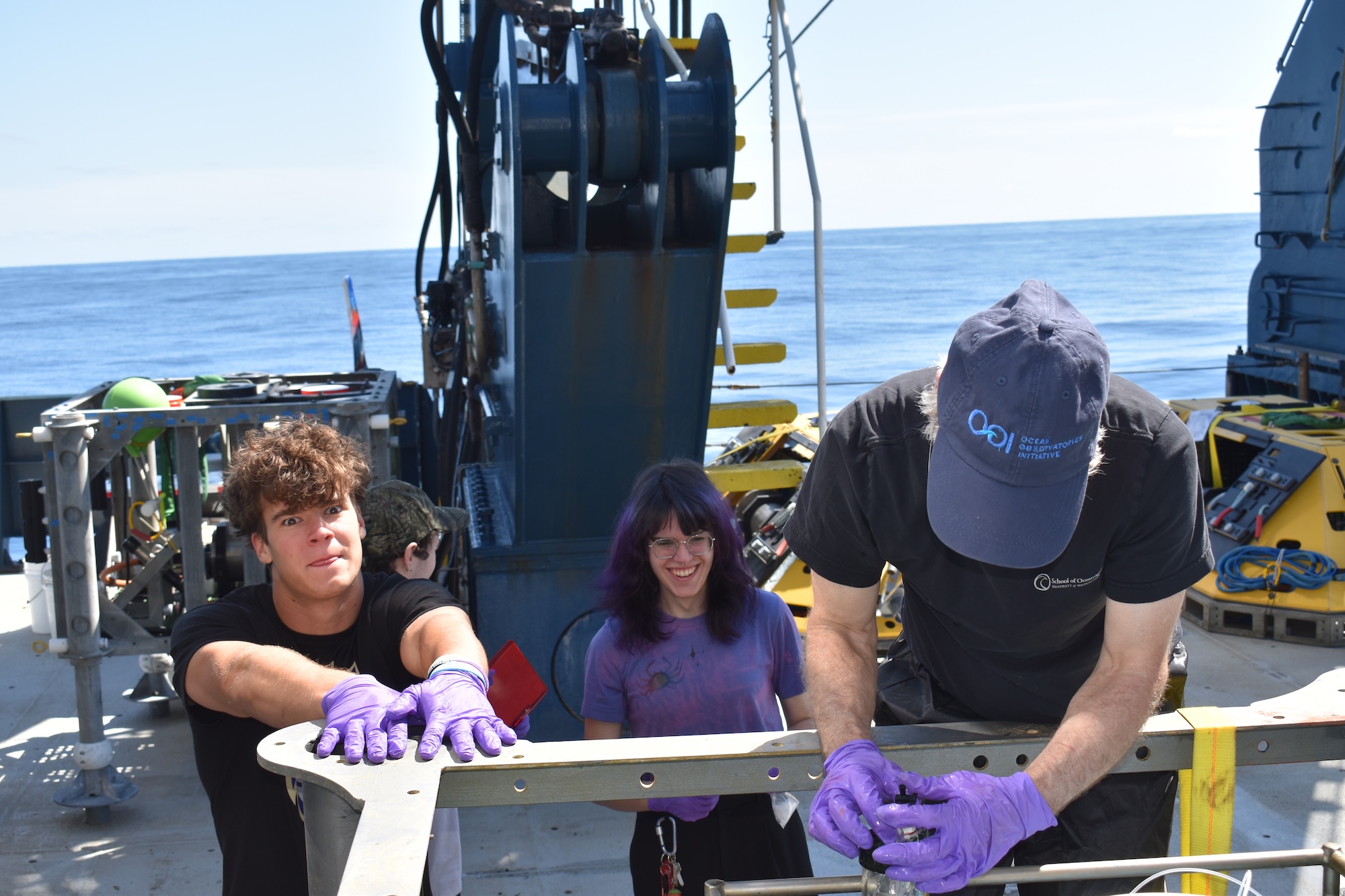
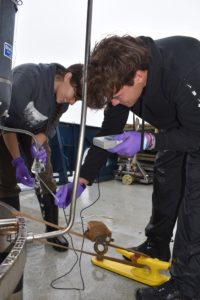
August 28, 2025
Given that this is our last full day on board, I’m going to use this blog as a reflection on the entire cruise itself. Firstly, I don’t even know where to begin. Doing something new every day has really affected me in such a positive way. Before this cruise, I was going through the motions of what seemed like the same day over and over again. When this happens, it seems like time flies by way too fast. But on this cruise, every day brought a new experience whether that was tag lining for the CTDs, seeing cool organisms in the Jason van, or learning about the huge wooly mammoth-sized ship itself, which really stretched that time and I enjoyed it a lot more.
When I first entered the Jason van, my mind was blown. It looked like a scene straight out of a video game. All the different monitors, all the different sensors, all the different lights contributed to a beautiful view of science at work. And, to be a part of it by logging, even if it is probably the least important task in the van, makes me feel special. Even outside of logging, when the entire science crew packed ourselves into the small van while Jason was touring some cool vent fields, it felt great. All the different things we saw: towering, castle-like structures of hydrothermal vents, strange organisms like the spider crab, or even the majestic scenery of the deep ocean all made this a truly unforgettable experience.
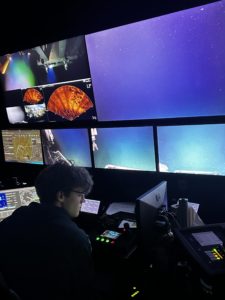
I got onto this cruise due to my interests in science and what better way to do science than doing it on a cruise! The student meetings every day led to some great introductions into all of the different positions onboard whether it be a biologist, Jason technician, or even the Captain of the ship himself. It was fun to be a pseudo-lab-technician and being able to work with all the different instruments the RCA and Atlantis had to offer. Priming the CTDs, sectioning the coils of the PPS, and plucking the scales of the scale worms were all activities I had fun in partaking in. I mean, it’s the main goal of what this research cruise was all about, and to actually be a part of it, is something I’ll never forget for the rest of my life.
Finally, this cruise wouldn’t have been the same if it wasn’t for the group of people I met while onboard. From Andrew’s humorous jokes to Jolee’s pure friendliness, everyone on board was super cool to meet and learn about what they were doing here. Every single, different person had a distinct story on what their background was and how they made it here. Everyone on board seemed to truly be passionate about what they were doing and I can’t stress enough how much of a blessing it’s been to be a part of this team. The connections I’ve made here, I hope to maintain for the rest of my life. Signing off for the year.
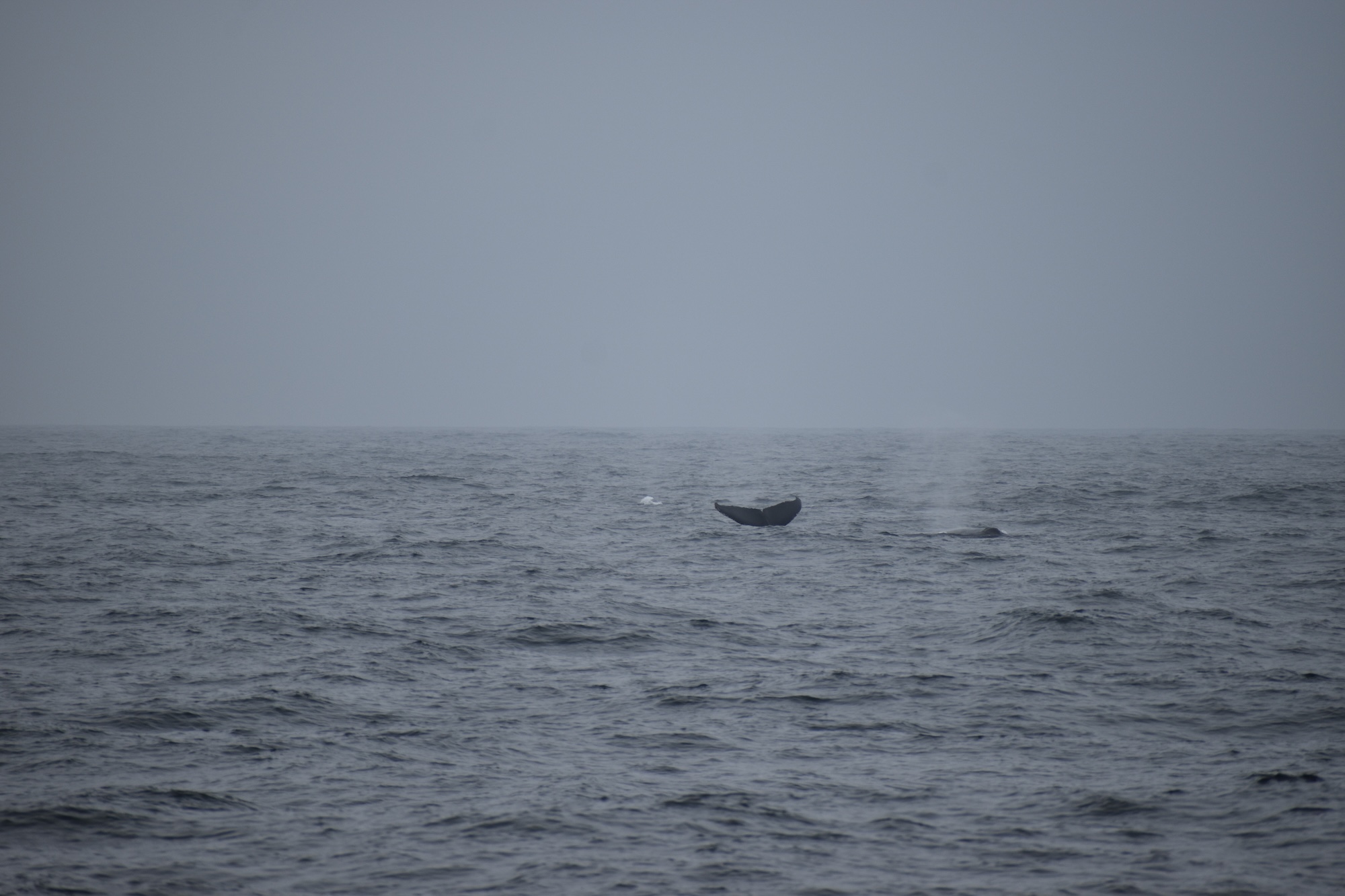
August 27, 2025
The weather is just too rocky to dive with Jason, so yet another day, another no-dive. I’m getting worried because I really wanted to make an authentic day-in-the-life video that includes going into the van and everything, but it looks like my time is coming to an end. Hopefully, I can do it tomorrow morning. Instead of diving this morning, a bunch of the engineering and science team decided it would be wise to converse on some of the world’s most polarizing topics including “100 men vs. 1 gorilla” and “are there more doors or wheels in the world”. It’s always fun to debate on riveting questions such as these, even if it is obvious that 100 men would completely atomize a gorilla.
Finally, the weather and swells were calm enough for Jason to go down. I wasn’t on shift, but I had nothing else to do so I watched the entire operation. We only dove to 80 meters, replaced a couple of instruments, and plugged in some cables so it only lasted 2 hours or so. Then, I had a good lunch of grilled cheese and tater tots, followed by a tasty dessert of viewing a pod of whales out on deck! It was so cool to see them surface, spout water, and then dive back under the surface. Even if all I saw was part of the tail, it was still a really cool experience that I wish I got on camera, but was too stuck in the moment.
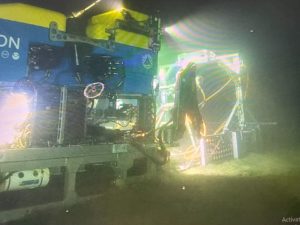
There wasn’t much going on today; we were transiting between the Oregon Offshore site and the Oregon Shelf site waiting for more weather delays due to swell to clear to deploy/turn additional instruments. During today’s student meeting, we got to meet the Captain of the R/V Atlantis, Derek, and he told us about his story in becoming a captain and what his daily activities look like. He had a crazy story about when he was out at sea near Reykjavik, Iceland, and there were waves as big as 60 feet! I can’t imagine what it would be like to sleep in that weather given how hard it is sometimes on this ship in our pretty much perfect weather.
Pizza was on the menu tonight for dinner and it was finished with some delectable brownies. Then, it was straight to the ROV van to go on back-to-back dives. Nothing that interesting was going on; we were just deploying another instrument and straightening out a camera. During the dive, I talked a little with one of the RCA technicians, Alex, about what he does for his position as it’s something I’m quite interested in. He told me that he was actually going to be leaving this next year and that he would miss it, which is always something that’s sad to hear. But, I’m excited for the potential of possibly being able to join the team. Anyways, my bedtime is approaching, and we have to present our project ideas tomorrow. Signing off for the day.
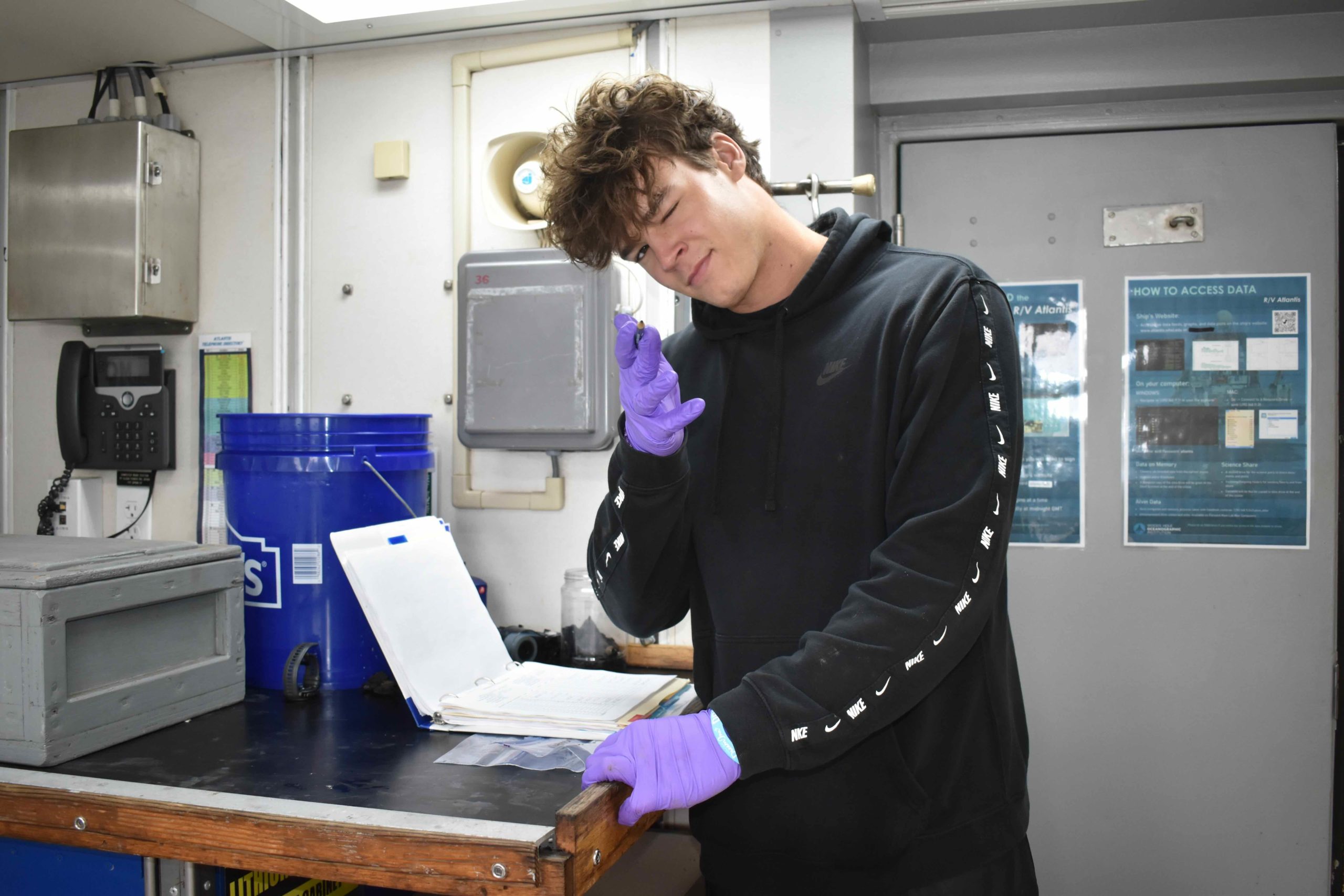
August 26, 2025
I woke up early again today expecting there to be a Jason dive so I can start on my day-in-the-life video, but apparently the swells were too high for the dive right now. This bad weather paired with the fact that we were only diving at 80 meters and bringing down 3200 lbs of payload made it dangerous conditions for Jason to dive in. So once again, I was left on my own with nothing to do for the next couple of hours. In times like these, I try to help out where I can, but there was literally nothing going on. So, I decided to start on this blog really early and fix some of the image files from my previous blogs.
The weather was still too rough for a Jason dive, so we decided to head back to the Oregon Offshore site where we would deploy some equipment with Jason. I have no idea why but this transit began to screw with my stomach a lot more than some of the other ones we’ve done. I went up to the library where it was nice and quiet and sat there with my acupressure bracelet. This uneasiness occurred right around lunch time and I didn’t even feel like having any lunch. But, I knew this would only make me more hungry later, so I decided to stomach a couple of fish tacos and an apple. At this point, we were finally approaching our site and we would get going with our first CTD deployment.
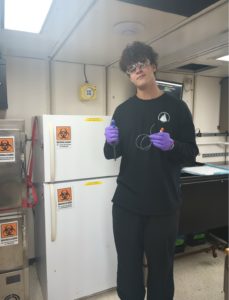
Same deal as yesterday, we processed the CTD samples, but this time, we got to swap our roles around. Yesterday, I was the temperature measurer and now today, I was the logger. It makes it fun when we swap roles because after a while, some of them get pretty boring after doing them constantly. After this, I wanted to really get started on my project ideas because I was told that we would have to present our ideas to Deb and Mike soon. I talked with Jolee a little about it and to line up with my possible future major change to biochemistry, I think I want to do my project on what DNA sampling looks like on the ship and what that can tell us. Very broad start, but I think it has potential.
After a nice dinner, I headed back into the Main Lab to finish working on this blog. And, right as I was thinking about how little stuff I did today, Alex grabbed me to do some sectioning. I haven’t really explained it, but essentially, sectioning is the process of slowly unravelling an extremely long coil of tube (1000+ meters) to create a time series of subsamples of either hydrothermal fluid or seep fluids/ seawater by cutting the coil at a specific length (depending on the flow rate) to measure fluid chemistry on a daily basis. Despite the fact that I lost the end of the coil multiple times and we had to spend a solid couple of minutes to find it in the amalgamation of coil, the process went smoothly and I went to bed shortly after. Signing off for the day.
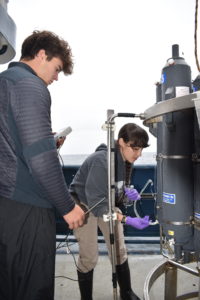
August 25, 2025
I woke up a lot later than normal today because I knew we were in transit so I would not have a watch shift. But even then, I had a pretty busy morning. I did some sectioning, a CTD deployment, and even made another styrofoam cup for my mom. I had a phone call with her last night. Texting with someone back home is one thing, but talking on the phone, getting to hear their voice is much better. Sounds like everything back home is going smoothly and I can’t believe we’ve been out here for a full eight days now. Well, now I’m getting summoned to rrecover the CTD.
After taking the CTD rosette out of the water, we had to begin the sampling process from the Niskin bottles. This included taking samples for oxygen, dissolved inorganic carbon, nutrients, and salinity. Once again, I can’t stress enough about how fun it is to actually be doing hands-on science in the field. Sometimes, I feel like I’m being a nuisance and I don’t want to overcrowd some of the already-cramped lab rooms, but I’m always trying to ask people around if they need help with anything. After the CTD sampling, we moved to the deepest part of our journey (9500 ft depth) where we were going to deploy another CTD.
I quickly went up into the galley where I was treated to one of my favorite meals of all time: Philly cheesesteaks. The food is ALWAYS good but today, our cook, Ben, really out did himself. After lunch, we deployed the CTD that would reach nearly 9500 ft beneath the oceans’surface. Attached to the underbelly of the rosette frame was a bag holding all of our little cups we drew on. About an hour goes by, and the next thing you know, the CTD was back on deck along with our little cups and they turned out perfect. It’s insane how much smaller they shrink due to the pressure difference. Now, it was time to move towards Southern Hydrate Ridge where we would do a Jason dive. The schedule lined up pretty perfectly in that as soon as we arrived, I would be on my watch shift.
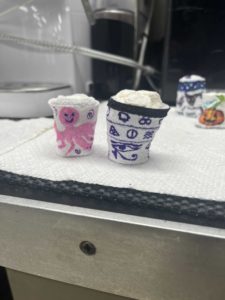
This was another mostly “entertainment” dive as we were going to take a tour of the methane seep site, which featured lots of cool biology and geology. This included things like, sea stars, all sorts of jellies, and hagfish. This was all a warm-up to the grand finale of a 80 meter tall calcium carbonate tower called the Pinnacle that’s produced by pH-changing microbes in the sediments. When the seawater’s pH is increased, calcium carbonate precipitates out and forms the colossal megastructure which many organisms like brittle stars, colonies of bacteria, and crabs call home. Signing off for the day.
August 24, 2025
I woke up a little earlier than usual because I wanted to get ready to make a day-in-the-life video on my phone today. However, when I got upstairs to the Main Lab, I realized that there was no dive going on this morning. At that point, I decided to save making the video for a day where we have a dive in the morning. That way, the video can get the true experience of what it’s like living on this ship as a student.
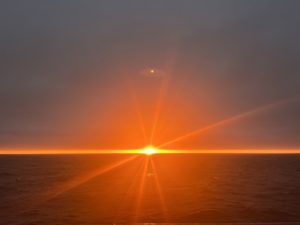
With nothing to do, I asked some of the ambassador students if they wanted any help. They at first wanted to do some tube sectioning, but because of a faulty setup, we postponed it until more people were awake to help fix it. I was told that we were going to do deploy the “cups” soon. The “cups” are little styrofoam cups that are sent down on the CTD to a depth of nearly 3000 meters. Because of the intense pressure, they shrink to a fraction of their original size. The idea is to draw some cool things on the cup before, and then when you send it down and back up, you’ll have a cool little souvenir. At first, I didn’t know what I should draw but my watch pardner, Jolee, gave me some inspiration with her Egyptian hieroglyphic cup. After finishing my cup, I enjoyed a really cool sunrise that came out under a dark line of clouds.
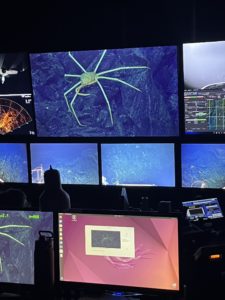
Today, Jason was going down to take a little tour from the International District south to the Skadi site, a snowblower in 2011. It was pretty awesome to see all of the gorgeous geology including collapse basins and tall pillars of basalt. We also saw tons of biological activity in the form of many rattail fish, cute blob sculpins, spider crabs, and even a half-eaten siphonophore. It was also such a neat experience to be in the Jason van with all of the other scientists observing and taking in everything this underwater tour had to offer. We ended up sampling a couple of the basalt rocks from the collapse basins and headed back up where we would be underway for the ~20 hour transit back to the Slope Base site.
On the way back, we got to take a tour of the engine room. It was a lot bigger and a LOT louder than I expected. The craziest thing I learned is that the ship can hold up to 300,000 gallons of diesel fuel. To put that into perspective, that’s about 51 semi-truck loads of fuel. While we were down there, I started to notice the swells a lot more which were much bigger than what I was getting used to. I finished off the day by helping our worm wizard on board, Andrew, whobegin processing his recovered scale worm samples for DNA sequencing. This involved the tricky task of plucking their micro-sized scales and putting them in a test tube. It was honestly really fun to do because removing each and every one of the super small scales and collecting them in a vial felt like a game. Signing off for the day.

August 23, 2025
After a horrible night of tossing and turning to get into the best sleeping position to accommodate for my back pain, I woke up to my alarm and quickly used the restroom. The other cool thing I haven’t mentioned is the spooky red light in our berthing restroom. It’s the only light source in the bathroom and it feels like being in a scene straight out of Alien. It gives off a very ominous and unsettling vibe like there’s an emergency going on, yet it puts out a lot of heat and makes the restroom very warm. It’s a love-hate relationship.
Today’s morning shift was pretty boring. We were doing a lot of water column survey work, which meant super slow movements through the water that allowed the multi beam sonar on Jason to get high resolution imaging of plumes. To be honest, it was pretty boring to log. But, that’s why having multiple other people in the van with you is such a blessing. Talking about random things and joking around really passes the time fast. Me and my watch partner, Jolee, talked about a variety of different things including how we got here, where we’ve travelled, COVID times, and even the meaning of our last names. It’s always fun to meet new people and see how they’ve got to where they’ve come.
Today’s tasks were to clean out the RAS sampling tubes with soap and water. All 50 of them. It was a lot more tiring than I thought it would be. They’re pretty wide and long tubes and we had to scrub the insides of them down hard with a brush. After finishing that, we headed up to the library for our daily student meeting.
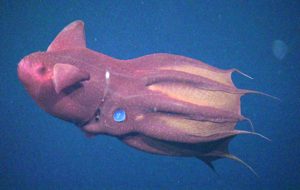
In today’s meeting, the Co-Chief Scientist, Mike, showed us a presentation on his study of deep sea biology. It was pretty cool to see how much stuff he’s done and all the diverse and interesting organisms that he’s imaged. My favorite part of his presentation was his picture of the coveted vampire squid. I hope we see one at some point in the Jason van even though they are pretty rare creatures.
Finishing out the day, I texted with some of my friends back home to see how things were going. We’re approaching the end of the cruise and while I’ll definitely miss these times out here, I’m happy I’ll get to see everyone at home again. I think on Monday is when we’ll transit back towards the Oregon Shelf where we’ll do a couple more tasks and finally head back very early morning on the 29th. I’m planning to make a day-in-the-life video on my phone tomorrow so I’m going to bed early so that I can set it up earlier tomorrow morning. Signing off for the day.
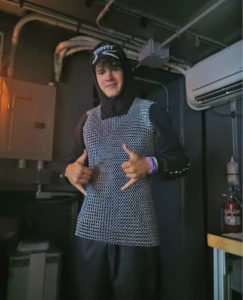
August 22, 2025
Another day, another 0400 wake-up call. I headed out to the van and Jason had just started descending to 1500 meters water depth. Today’s main job was to use Jason’s multi beam sonar to survey the area. However, this was the first time I’ve been in the van and things started to go wrong. The sonar wasn’t pinging to the scientists computers so we had to wait a pretty long time in between sweeps to reset the computer and make sure things were fully functioning. Which was fine, because it gave us time to talk about random stuff including about how one of the Jason technician’s hobbies was making armor he brought – his chainmail chest armor which he let me put on.
We’re approaching the halfway point of the trip now and I can’t believe it. The days have gone by so fast. Probably due to how much of a routine I’m in now with my watch shifts. But, since we’ve been out here for a while, there was one issue: my clean clothes were running out. I had Deb show me where the laundry room was on the very bottom of the ship. It was a little scary going all the way down there; It was quiet and no one was around. But, it was good to finally refresh my stock of clean clothes and it should last me the rest of our cruise.
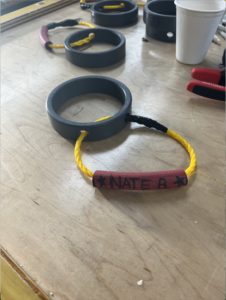
In the afternoon, I somehow ran out of my WiFi allotment for the day even though I barely even used any. We figured that I must have been downloading something in the background. But, it didn’t matter because I was kind of busy with stuff the rest of the day. This included the arduous task of “marlin-spiking,” which is basically the process of intertwining polypropylene cord to make a stronger cord – we made these cords for the Jason team. They loop these cords around the locking mechanism of the basket they bring down to the depths with them. There’s a chance they will actually use the one I made on a dive and I’ll get to see it go down. I just hope mine doesn’t fail and cause a catastrophe.
I somehow pulled a muscle in my back at some point today and it’s pretty painful to move around much. I thought it would feel better when I woke up, but when I laid down in bed, it only got worse. It was much harder to fall asleep this night which made it even more of a pain to get up for my morning shift. Anyways, hopefully there would be some breaks in between the plans for tomorrow so I might be able to rest. Signing off for the day.

August 21, 2025
I got up at 0340 and headed straight out to the Jason van. It was kind of a strange wake up; When I got to the upper levels, I was so used to seeing at least a couple of people in the Main Lab or on deck. But, there was no one this morning. It was a little eerie especially with the pitch black darkness of the surrounding waters all around me. But as soon as I got to the van, the bright lights of the uncountable amount of computer monitors in the van woke me right up as I swapped watches with my roommate.
Today’s shift was a lot more exciting than some of my past ones. There was a ton of different organisms we caught on camera today including a bunch of rattail fish, blob sculpins, and even a rare sighting of an octopus on the seafloor! The main objective while I was on shift was swapping out instruments called MISOs (couldn’t really understand what they did) at the different vent sites. We also collected a couple of really neat rock samples from different collapse basins on the seafloor that were surrounded by super cool-looking formations called pillow basalts.
After my shift, I went up to the galley to grab a quick lunch and ate fast because we were going to do some lab work today. We were processing the RCA RAS (Remote Access Sampler) samples from the Tiny Tower vent fluids. We had about 6-7 people in the lab at a time going through an assembly line of stations. My favorite part about the lab work we do on ship is both learning about how different processes and methods work, and the social aspect. We spent about 4 hours doing this entire line of sample processing and we talked about the most random stuff which I enjoyed.
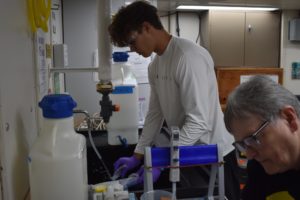
After the tiring ,but enjoyable labor of the lab work, I got some dinner with my roommate. We had some grilled lamb and basmati rice which was followed up by a quite delectable chocolate cherry cake. I was also told that some people saw whales today, which was pretty annoying given no one came and told me. I hope I’ll see some between now and when we leave. Now I was on shift, but Jason wasn’t diving so I had free time to watch YouTube and play on my DS for the rest of the night. And after a pretty fun day, I decided to hit the hay around 2000 hour to hopefully get a full 8 hours of sleep. Signing off for the day.
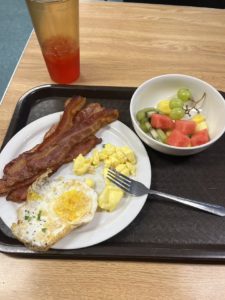
August 20, 2025
Another early wake up for today, but today’s Jason tasks were a lot more exciting. I got in the van and was immediately logging for the descent to the “Mushroom vent”. When we got down to the bottom, we needed to bring an old instrument back up with Jason but when we got there, it turns out a new vent actually grew right inside of it! The craziest part about it is that they dove down here on Leg 1 of the cruise and that vent wasn’t there. This meant that it only took a couple of days for this whole new vent to construct itself. I find it absolutely amazing just how fast they can erect themselves.
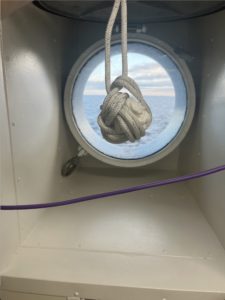
One thing that I feel like I haven’t emphasized enough is the amazing food that’s available to us on the ship. Going into this, I envisioned the meal choices were going to be limited and the food would be subpar. I’m so happy to say that it’s quite the opposite. There’s always a variety in what we eat whether it be seafood, tacos, or even Chinese food! I was talking with Deb about how impressed and she said good food on a ship really helps keep good spirits up. And I totally believe her; I can’t imagine what this trip would have been like if I had something like mashed potatoes and questionable, gray meat every day.
Not a lot is going on today. Everyone that I talk to is always telling me, “it’s feast or famine” when it comes to stuff do on the ship. Another thing I haven’t really talked about is how isolated I feel out here. I can’t really explain the feeling, but it reminds me of when I go camping in the woods sometimes; Like, I feel a little alone and depressed even though I know I shouldn’t be feeling those feelings. There’s 60 other people on the ship and there’s always exciting stuff going on, yet I still can’t shake the weird feeling.
My afternoon shift was completely free time. No dive was going on, but there was still nothing really to do. Until, one of our graduate students, Andrew, showed me a big book of knot-tying techniques and I made it my goal to do as many as I could before I had to get ready for bed. The one that was the coolest to me was the Monkey Fist. It was a really complicated knot to understand and complete, but it looked very flashy so I did my best and kind of got the hang of it. You can see my finished product in the attached figures. After completing my Monkey Fist, I figured it was time for bed. Signing off for the day.
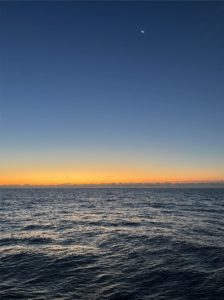
August 19, 2025
I had my first early morning watch shift this morning at 0400. My alarm went off at 0340 and I had to quickly shut it off because the walls between rooms are probably a micrometer thick and I didn’t want to jeopardize my neighbor’s sleeping. I quickly threw on some clothes and headed out into the van, hoping whatever Jason was doing would wake me up. On the walk over to the van, I realized how dark my surroundings were out on deck. The horizon was pitch black. The water was pitch black. Rushing to the van, I tried not to think about what would happen if I fell in.
This shift wasn’t that bad at all. I got on basically at the tail end of the dive, so all I had to do was log Jason coming out of the water. During the somewhat mundane events of the retrieval operation, I learned a lot of cool stuff from the people in the van including meanings of the ever so infinite amount of acronyms that I keep hearing (reminds me of listening in on my mom’s Zoom work meetings. She knows what I mean. (Hi mom), how fiber optic cables worked, and wisdom for future Gen Ed classes that I’ll be taking. The best part about having a super early morning shift, is the spectacular view of the sunrise you get to witness. I felt like Luke Skywalker in a New Hope gazing out at the serene myriad of colors the Sun was creating. It’s one thing to see a picture of a sunrise, but it’s a totally different experience to actually see one with your own eyes.
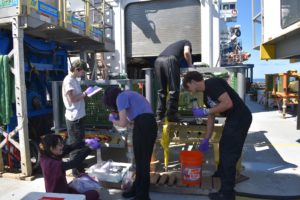
Today, I learned what a RAS is (Remote Access Sampler) and I took part in the retrieval and logging of the device. The RAS was attached to Jason as it descended and the sampling system (vent cap was installed at the Tiny Towers vent site. The one deployed in 2024 was recovered, which was able to capture 49 different samples of the actual vent fluid. When it was brought to the surface, we put it into a cooler and loaded all of the sample containers into the ships 4°C freezer onboard. From these samples, we can take them back into the lab and analyze all sorts of chemical aspects of the vent fluid (hydrogen sulfide, methane, etc.).
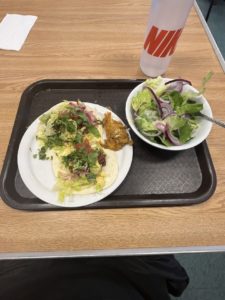
After a great lunch of Taco Tuesday, I headed back down into the Main Lab to continue working on my blog and get ready for my final shift of the day. One of my more experienced peers came over to me and we talked about what I wanted to do for my project out here. I thought I had it all figured out, but after talking to him about it, it seems as if I’m way in over my head with what I want to do. I’m thinking of switching my major to biochemistry, so I wanted to do something within that realm for my project. But, everything we were talking about doing sounded so confusing and convoluted for just an incoming sophomore like me. I don’t think he knows just how inexperienced I am and I don’t think I know how far of a rabbit hole I’m going down. I’m still not sure what I want to do. As I headed back out to the Jason van, I pondered on how I was going to get this project done.
I had another relatively easy shift as all Jason installed a new TRHPH (Temperature Resistivity Probe) and brought the old one that was in the vent Escargot back up to the surface. Then when it surfaced, I was allowed to leave the van room and have free time even though I was still on shift (best feeling ever). I asked around and it looks like all of our dive planning is still on schedule so we are still on pace to be back in port on the 29th. Got another 0400 watch shift tomorrow. Signing off for now.
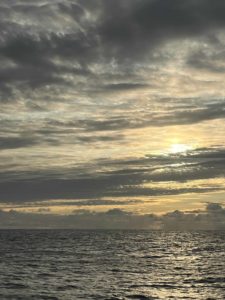
August 18, 2025
It was a pretty rough night of sleep last night because when we are steaming, the swells are crazy strong. Tossing and turning, I tried to maintain the most comfortable position while blocking out all the noise. And, it also didn’t help when I was woken up at 0445 by a fellow scientist who told me I had to start adjusting my sleep schedule for my Jason watch hours (which were 0400-0800 and 1600-2000). I was slightly annoyed by cutting my sleep off early a couple hours, but I knew it was for the better as this would be my wake-up time for the next week or so, so I had to get used to it.
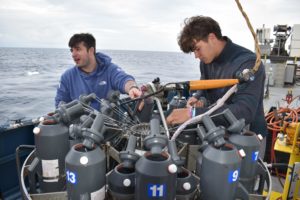
Well, we finally arrived at Axial Seamount and it was time to deploy our first CTD. As I walked out onto the deck, the sunrise was purely majestic and it filled me with inspiration and excitement for the day. While deploying the CTDs, I learned my first couple of knot-tying techniques including the Bowline and the Clove Hitch. These were essential for making sure the massive bulk of the CTDs made it into the water safely and securely. The deployment and retrieval of this system is a full process in their respective parts, requiring multiple hands-on deck for the operation to run smoothly.
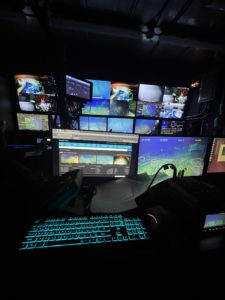
After finally getting the CTD samples back onboard, I helped in recording the samples and chemically altering them to see how much different stuff was in it. This “stuff” included things like dissolved oxygen, dissolved organic carbon, and nutrients. First, for dissolved oxygen samplers, we would collect a sample from one of the CTD Niskin bottles into a beaker, and add a reagent to form a precipitate. We can then use that precipitate to stoichiometrically calculate how much actual dissolved oxygen was in the ocean water sample. One of the reagents we used (for the dissolved organic carbon) was mercuric chloride, which is a HIGHLY toxic substance in which the handler needed to equip double disposable gloves on each hand to safely handle the poison. I was just the scribe, so I didn’t have to worry about it. It was also about this time, when our star Remotely Operated Vehicle (ROV), Jason, got deployed.
My first watch shift of the cruise started at 1600 and lasted till 2000. It was a super exciting shift because we were doing close-up visuals on some of the hydrothermal vents (Escargot and Diva). It was really cool to see everything that was going on down there including vent organisms like tube worms that chemosynthetically turn the iron sulfide venting out of the orifices into energy and biomass. I can’t lie, I was getting a little tired towards the end of my shift and was happy to be relieved by a fellow student so that I could finish this blog and finally head to bed. I’ve got to be back up at 0400 for my next shift. Signing off for now.
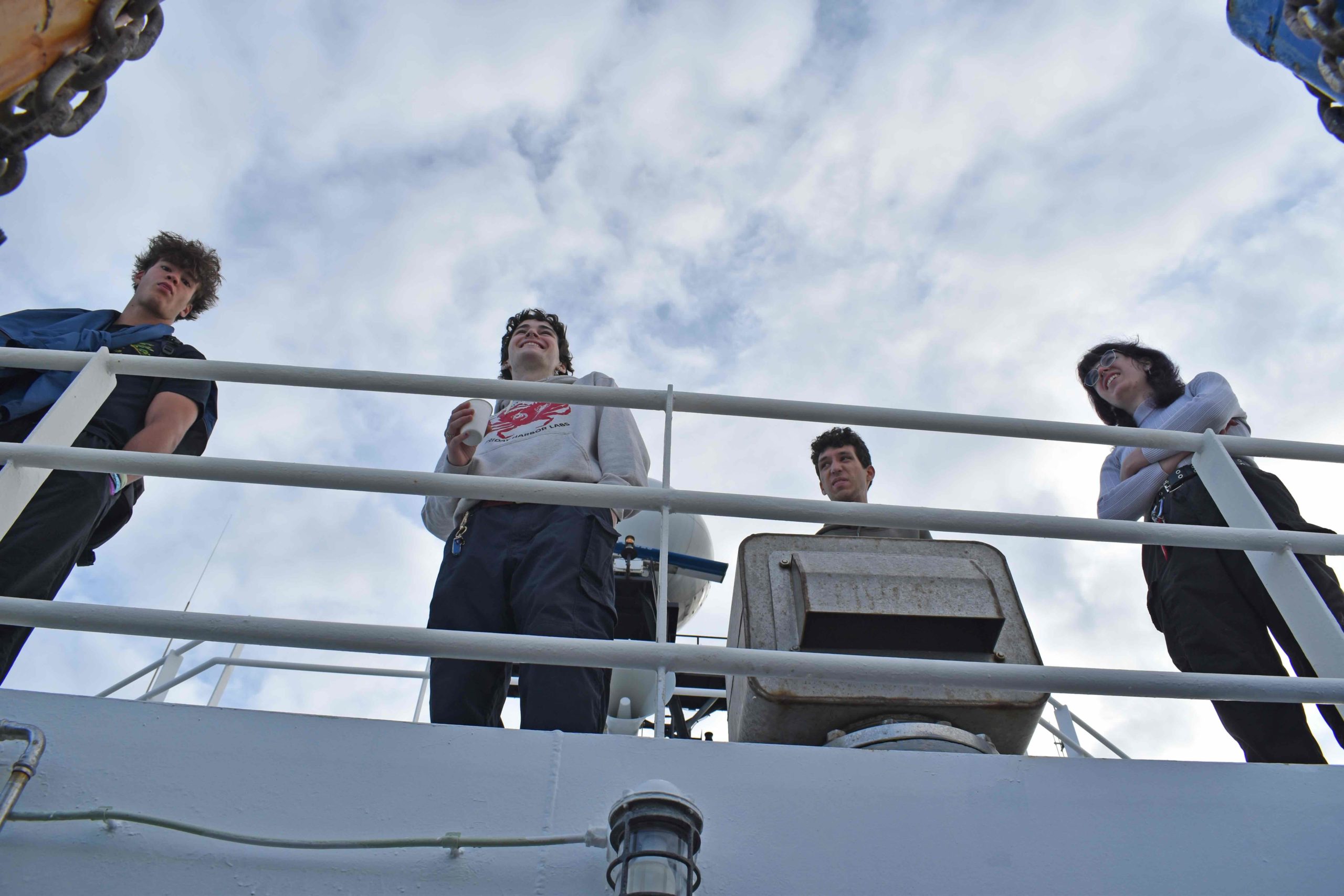

August 17, 2025
I woke up very early today (at least in my standards) at the ripe time of 0700. Today was departure and everyone had to be in the Main Lab by around 0830 to go over safety training. I slipped on some clothes and headed up into the galley for some much breakfast. I had my first experience with the ship food and to my surprise, it was much better than what I thought it was going to be. After the wonderful breakfast of champions (bacon and potatoes), I scurried back into my berthing to take a quick shower so that I could be in the Main Lab by 0830.
After my shower, I noticed we were finally taking off so I went out on deck and waved goodbye to land while enjoying the sea breeze and looking into the water where we saw tons of jellyfish and seals drifting about. Some seals were smart enough to shore up onto the large buoys in the middle of the ocean to rest. With Newport and the rest of terrestrial land began to fade behind us, I headed back into the Main Lab to go over our safety meeting.
The ship crew went over basic safety protocols including taking us out onto the deck to see where each of us would go in an “abandon ship” scenario. They showed us our emergency lifeboats and how to put on our life vests. Then we headed back into the Main Lab for the finale of the safety meeting: putting on our emergency wetsuits. This thing was a nuisance to get on! I had to sit down on the ground to get both my legs in the suit and only then could I stand back up, slip on my arm sleeves, pull over my hood, and strap the hood around my mouth. This was a very uncomfortable experience and it was right around the time where I started getting my first symptoms of seasickness.
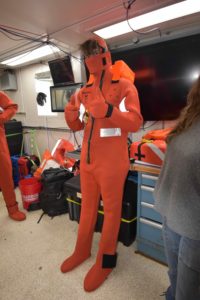
Now, I had never been on a real vessel like this before so I didn’t know if I was naturally a seasick kind of person. I was in for a rude awakening. My stomach felt absolutely dismal and I was starting to sweat uncontrollably. I took some more Dramamine and went back out onto the deck to get some fresh air. While this somewhat quelled the uneasiness, as soon as I got back inside, it came back. This time, I decided to just sit down in the library, put on a neat acupressure bracelet my mom got me (thanks mom), and whipped out the 3DS to play some video games hoping it would calm me down. After a while, the nausea died down a lot and I felt a lot better so I headed back up into the main lab to see what the plan was for the rest of the day.
Apparently, today was a very chill day because we’re just going to be steaming all the way out to Axial Seamount, which will take around ~20 hours. We have CTD (conductivity temperature depth measurements) training later on today, but for the time being, I’m just going to relax and hopefully completely trump my seasickness symptoms. Signing off for the day.
